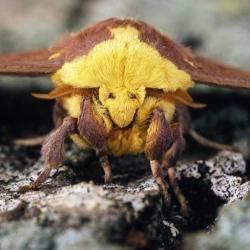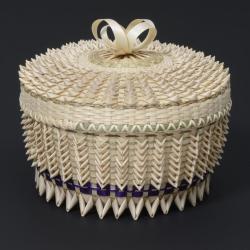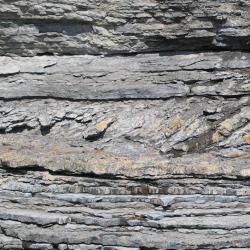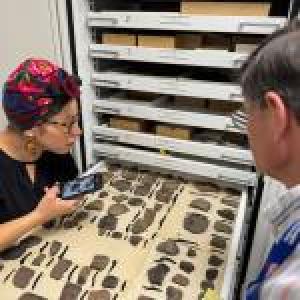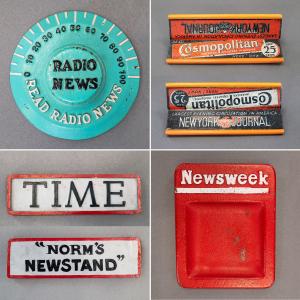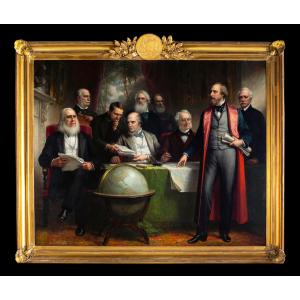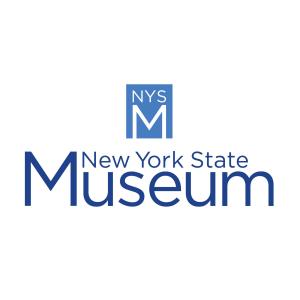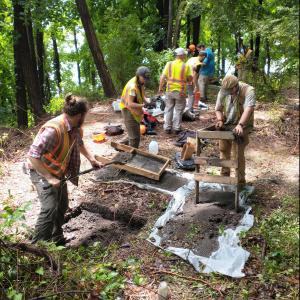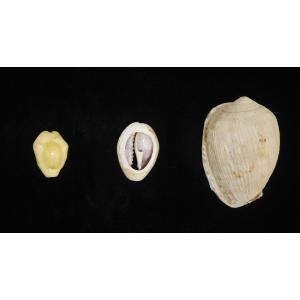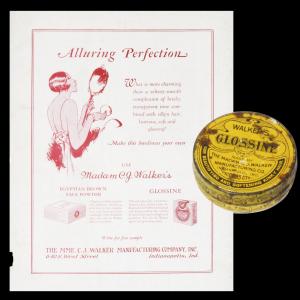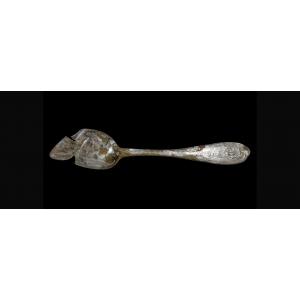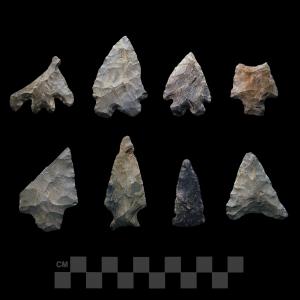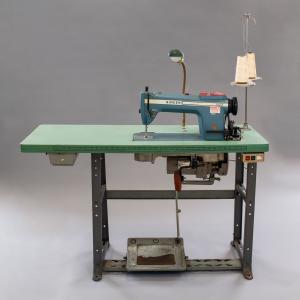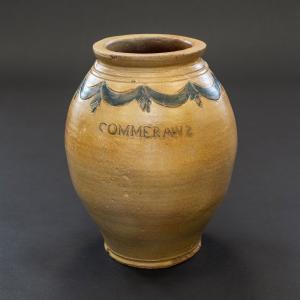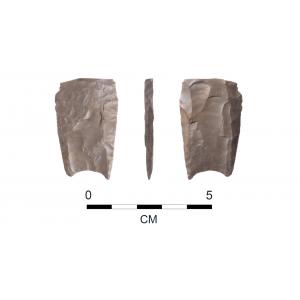Research & Collections
From its beginning in 1836, the New York State Museum has been home to some of the nation’s leading scientists, including pioneers in archaeology, paleontology, ethnology, and botany. Its collections now rank among the finest in many fields and total more than sixteen million specimens, objects, and artifacts.
Research at the New York State Museum today is as exciting as it is varied, with scientists and historians actively directing projects in biology, anthropology, geology, paleontology, and history. Research by staff represents one tangible way in which information about the natural and cultural histories of New York, and the world, is made available to the public. Research findings are presented in scholarly and popular publications, at professional meetings, in exhibitions, and in public programs.
Researchers throughout the world use the collections of the New York State Museum to address questions about New York's natural and human heritage. The Museum’s collections are made available to researchers and scholars and are also used in exhibitions and public programs. Participation in Museum collections curation and research projects is possible through internships and volunteer opportunities.
To explore the Museum’s Research and Collections Division, hover your mouse over the Research and Collections block at the top navigation bar.
News Articles
Coupling Indigenous Artwork and Ancient Artifacts
Published January 22, 2024 | Native American Archaeology
The New York State Museum maintains its extensive material collections for the benefit of individuals and communities across the New York region and beyond. Increasingly, indigenous scholars, artists, and community members are accessing the NYSM's...
From the Collections: Shakers and the New York State Museum
Published January 17, 2024 | Social History
New Publication on the Devonian Features Significant Contributions from NYSM Geologist
Published December 11, 2023 | Devonian Geology
The Devonian Period occurred between 419.2 million and 358.9 million years ago. Devonian-age rocks in New York State have been utilized by geologists, paleontologists, and educators to study the development of life, understand geological ...
Spiller Newspaper Paperweight Collection
Published December 7, 2023 | Cultural History
Mortimer Spiller was born in 1922 to Russian immigrants who settled in LeRoy, New York. Spiller’s college training in business and advertising was interrupted by service in World War II. After the war, he was eager to complete his education and pu...
The Atlantic Cable Projectors (1895) returns to the New York State Museum
Published December 5, 2023 | Cultural History
Daniel Huntington (1816–1906) The Atlantic Cable Projectors, 1895 Oil on canvas
NYSM's State Survey Geologists join federal partners in collaborative Aerial Mapping Project in Northwestern, New York
Published September 29, 2023 | Geologic Mapping
Geologists within the New York State Museum have been conducting geological mapping in partnership with the United States Geological Survey (USGS) for 40 years. This long-standing collaboration has helped the State Museum study and map the distrib...
Indigenous Activity in the Hudson Highlands
Published August 1, 2023 | CRSP
Archaeologists from the NYSM’s Cultural Resource Survey Program kicked off this year’s field season with a survey in the Hudson Highlands in an area overlooking the Hudson River not far from Manitou Mountain. This is within the traditional homelan...
The NYSM's Bald Eagle
Published July 3, 2023 | Ornithology
Happy Fourth of July from the NYSM! This bald eagle, currently on display in Birds of New York Hall, is one of the oldest specimens from our collections and even pre-dates the discovery of the Cohoes Mastodon by sixteen years! The specimen, an adu...
NYSM Bioarchaeology Staff Study Remains of Revolutionary War Soldiers
Published May 11, 2023 | Bioarchaeology
In 2019, bones dating back to the late 18th century were uncovered at a Lake George Village construction site. For the past four years, NYSM bioarchaeology staff Lisa Anderson, Julie Weatherwax, and Alexandra DeCarlo have been working together wit...
Reticulated Cowrie Helmet Shells: A Small Reminder of the Link between New York and the Caribbean
Published February 23, 2023 | Historical Archaeology
Billions of Moneta and Annulus cowries from the Indian Ocean were traded for enslaved people along the west coast of Africa from the 15th through 19th centuries. Much larger reticulated cowrie helmets, native to the w...
From the Collections: Madam C.J. Walker’s Glossine Hair Paste and Advertisement
Published February 22, 2023 | Social History
Madam C. J. Walker (1867–1919) was a successful entrepreneur, businesswoman, philanthropist, and social and political activist during a time when both African Americans and women were not common in the world of business. In 1906, she started her o...
African American Farmers in the Upper Hudson Valley, 1820–1880
Published February 7, 2023 | Historical Archaeology
Agriculture has been central to the cultural history of the Hudson River Valley from the first indigenous farmers to 17th-century Dutch farms, and finally through the development of modern mechanized farming during the 19th century. Regrettably, t...
Science Tuesday: "Living Fossils!"
Published December 12, 2022 | Ichthyology
Bowfin fishes are recognized as evolutionary relicts or ‘living fossils’ that historically were distributed worldwide, going back almost 150 million years and living alongside dinosaurs. These fishes retain many of the morphological traits of thei...
Science Tuesday: DNA Research in Ornithology
Published December 12, 2022 | Ornithology
Museum specimens are important sources of DNA, used by researchers to discover the evolutionary relationships among species. NYSM zoology curators save small samples of muscle and other tissues from the specimens they prepare for our collections. ...
The McVaugh Donation: Important Collections Come in Small Packages
Published November 28, 2022 | Native American Archaeology
Over the years, the NYSM has received donations of very large archaeological collections numbering hundreds of thousands of specimens—but small collections can also be important. One such donation, modest in size but rich in content, was...
Transporting Grains on the Erie Canal
Published October 25, 2022 | Economic History
On October 26, 1825, the Erie Canal officially opened from Albany to Buffalo. The canal was an immediate success: shipping costs plummeted, and new services and goods became widely available. Cheap, reliable transportation opened new markets ...
New Acquisition: Singer Industrial Sewing Machine, ca. 1972
Published September 14, 2022 | Social History
One sewing machine, two stories: Some artifacts in our collection hold the stories of multiple individuals. This ca. 1972 Singer industrial sewing machine, recently donated to the NYSM, belonged to Tsui Ping Chu, an immigrant from Hong Kong. Ch...
Science Tuesday: Uncovering Commeraw Stoneware
Published August 2, 2022 | Historical Archaeology
New York stoneware vessels bearing the name “Commeraw” have been included in collections for years, but more recently they have become recognized for their historical importance. Thomas Commeraw was an African American potter who worked in the Cor...
Science Tuesday: Late Ice Age Stone Point
Published July 25, 2022 | Native American Archaeology
Located in the middle reach of the Hudson River, Magdalene Island (Dutchess County, NY) has long been known to archaeologists as a location visited by ancient indigenous peoples. Until now, stone tools and other artifacts curated at the NYSM sugge...




